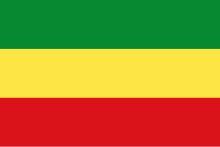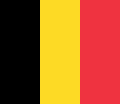Pan-African colours


Pan-African colours is a term that may refer to two different sets of colors:
- Red, yellow, and green, the colours of the flag of Ethiopia, have come to represent the Pan-Africanist ideology. Numerous African countries have adopted the colors into their national flags, and they are similarly used as a symbol by many Pan-African organisations and the Rastafari movement.
- Red, black, and green, first introduced by Marcus Garvey in 1920, have also come to represent Pan-Africanism, and are shown on the Pan-African flag. These colors have also been incorporated on national flags, and they have sometimes been used to represent black nationalism rather than Pan-Africanism.[1]
The Ethiopian colours[]
| Part of the Politics series on |
| Pan-Africanism |
|---|
 |
|
Green, gold and red are now found on the national flags of many African nations. The colour combination was borrowed from the flag of Ethiopia.[citation needed] The Ethiopian flag has influenced the flags of many Pan-African organizations and polities. Except for relative brief periods of influence and occupation by the Kingdom of Italy, Ethiopia remained outside European control during the colonial era by defeating the Italian army at the battle of Adwa, Ethiopia, in 1896, ending the Italian protectorate. As a result, the country drew the admiration of many newly independent states in Africa. The adoption of the Ethiopian national colours by many Pan-African entities is a consequence of this. The first African state to adopt a gold, red and green flag upon independence was Ghana in 1957, designed by Theodosia Okoh.[2][3]
The UNIA colours[]
The Universal Negro Improvement Association and African Communities League (UNIA) founded by Marcus Garvey has a constitution which defines red, black, and green as the Pan-African colours: "red representing the noble blood that unites all people of African ancestry, the colour black for the people, green for the rich land of Africa."[citation needed] The UNIA flag was designated the official colours of Black Africans by the UNIA at its convention in Madison Square Garden on August 13, 1920 in New York City, United States.
Current country flags with the Pan-African symbolism[]
The following are countries and territories that use one or both sets of Pan-African colours in their official flags:

Ethiopia (official) 
Comoros 
Republic of the Congo 
Eritrea 
Benin 
Chad 
Mauritania 
Senegal 
South Africa 
South Sudan
Non-national flags[]

African National Congress 
African American flag by David Hammons 
Sudan Liberation Movement/Army 
Union of African States (1958–1961) 
Union of African States (1961–1962)
Former flags with pan-African colours[]

Biafra (1967–1970) 
Cape Verde (1975–1992) 
People's Republic of Congo (1970–1991) 
Malawi (2010–2012) 
Rwanda (1961–2001) 
South Kasai (1960–1961) 
Zaire (Congo-Kinshasa) (1971–1997) 
Flag of Ethiopia (1987–1991)

Flag of Sudan (1956–1970)

Flag of Tanganyika (1961–1964)

Flag of Senegal (1958–1959)
Non Pan-African flags with Pan-African colours[]
Although the following flags contain a Pan-African colour scheme, they are not intended to symbolise Pan-Africanism. Rastafari colours also originate from the Ethiopian flag, but though RastafarI thought harbours Pan-African sympathies, its use of the Ethiopian flag is historically rooted in the veneration of former Ethiopian emperor Haile Selassie.

Aboriginal Australians 
Afghanistan 
Burma (1943-45) 
Ethiopian Empire 
French Guiana (unofficial) 
Grenada 
Belgium 
Germany 
Libya 
Haiti (1964–1986) 
Papua New Guinea 
Rojava 
Saint Kitts and Nevis 
Vanuatu
See also[]
- Flag of Lithuania
- Malay tricolour
- Nordic Cross Flag
- Pan-African flag
- Pan-Arab colours
- Pan-Slavic colours
- Tricolour
- United States of Africa
References[]
- ^ Shelby, Tommie (October 2003). "Two Conceptions of Black Nationalism". Political Theory. 31 (5): 664–692. doi:10.1177/0090591703252826. ISSN 0090-5917.
- ^ "Mrs Theodosia Okoh: The Woman Who Designed The Ghanaian Flag", African Celebs.
- ^ Mrs. Theodosia Salome Okoh Profile at GhanaWeb.
- Znamierowski, Alfred (2001). The World Encyclopedia of Flags: The Definitive Guide to International Flags, Banners, Standards and Ensigns. London: Anness Publishing.
- African culture
- African-American culture
- African-American history
- Color schemes
- Flags by colour
- Pan-Africanism
- Rastafari
- Symbols of Africa
- Vexillology






























































